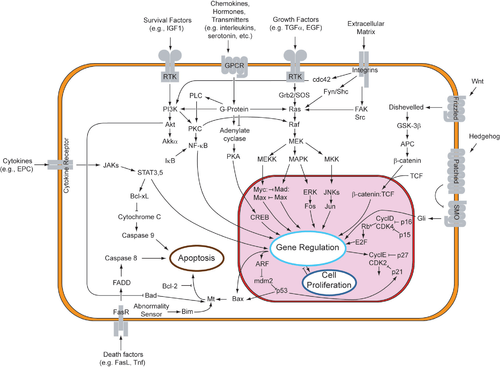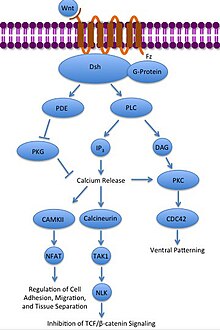Paracrine signaling
In

Although paracrine signaling elicits a diverse array of responses in the induced cells, most paracrine factors utilize a relatively streamlined set of receptors and pathways. In fact, different organs in the body - even between different species - are known to utilize a similar sets of paracrine factors in differential development.[1] The highly conserved receptors and pathways can be organized into four major families based on similar structures: fibroblast growth factor (FGF) family, Hedgehog family, Wnt family, and TGF-β superfamily. Binding of a paracrine factor to its respective receptor initiates signal transduction cascades, eliciting different responses.
Paracrine factors induce competent responders
In order for paracrine factors to successfully induce a response in the receiving cell, that cell must have the appropriate receptors available on the cell membrane to receive the signals, also known as being competent. Additionally, the responding cell must also have the ability to be mechanistically induced.
Fibroblast growth factor (FGF) family
Although the FGF family of paracrine factors has a broad range of functions, major findings support the idea that they primarily stimulate proliferation and differentiation.
One of the most important functions of the FGF receptors (FGFR) is in limb development. This signaling involves nine different
Additionally, paracrine signaling of Fgf is essential in the developing eye of chicks. The fgf8
Phenotype and survival of mice after knockout of some FGFR genes:[5]
| FGFR Knockout Gene | Survival | Phenotype |
|---|---|---|
| Fgf1 | Viable | Unclear |
| Fgf3 | Viable | Inner ear, skeletal (tail) differentiation |
| Fgf4 | Lethal | Inner cell mass proliferation |
| Fgf8 | Lethal | Gastrulation defect, CNS development, limb development |
| Fgf10 | Lethal | Development of multiple organs (including limbs, thymus, pituitary) |
| Fgf17 | Viable | Cerebellar Development |
Receptor tyrosine kinase (RTK) pathway
Paracrine signaling through
Binding of FGF to FGFR
An

RTK receptor and cancer
Paracrine signaling of growth factors between nearby cells has been shown to exacerbate
RTK pathway and cancer
Research on
JAK-STAT pathway
In addition to RTK pathway,
After dimerization of the cytokine receptors following ligand binding, the JAKs transphosphorylate each other. The resulting phosphotyrosines attract STAT proteins. The STAT proteins dimerize and enter the nucleus to act as
Phenotype and survival of mice after knockout of some JAK or STAT genes:[16]
| Knockout Gene | Survival | Phenotype |
|---|---|---|
| Jak1 | Lethal | Neurologic Deficits |
| Jak2 | Lethal | Failure in erythropoiesis |
| Stat1 | Viable | Human dwarfism and craniosynostosis syndromes |
| Stat3 | Lethal | Tissue specific phenotypes |
| Stat4 | Viable | defective IL-12-driven Th1 differentiation, increased susceptibility to intracellular pathogens |
Aberrant JAK-STAT pathway and bone mutations
The JAK-STAT signaling pathway is instrumental in the development of limbs, specifically in its ability to regulate bone growth through paracrine signaling of cytokines. However, mutations in this pathway have been implicated in severe forms of dwarfism:
JAK-STAT pathway and cancer
Research on paracrine signaling through the JAK-STAT pathway revealed its potential in activating invasive behavior of ovarian
Hedgehog family
The
Hedgehog signaling pathway


Members of the Hedgehog protein family act by binding to a
Hedgehog signaling pathway and cancer
The Hedgehog Signaling pathway is critical in proper tissue patterning and orientation during normal development of most animals. Hedgehog proteins induce
Wnt family

The
The canonical Wnt signaling pathway

In the
The noncanonical Wnt signaling pathways
The noncanonical Wnt pathways provide a signal transduction pathway for Wnt that does not involve
The noncanonical planar cell polarity (PCP) pathway

The noncanonical PCP pathway regulates cell
The noncanonical Wnt/Ca2+ pathway

The noncanonical Wnt/Ca2+ pathway regulates intracellular calcium levels. Again Wnt binds and activates to Frizzled. In this case however activated Frizzled causes a coupled G-protein to activate a phospholipase (PLC), which interacts with and splits PIP2 into DAG and IP3. IP3 can then bind to a receptor on the endoplasmic reticulum to release intracellular calcium stores, to induce calcium-dependent gene expression.[31][32][33]
Wnt signaling pathways and cancer
The Wnt signaling pathways are critical in cell-cell signaling during normal development and embryogenesis and required for maintenance of adult tissue, therefore it is not difficult to understand why disruption in Wnt signaling pathways can promote human degenerative disease and cancer.
The Wnt signaling pathways are complex, involving many different elements, and therefore have many targets for misregulation. Mutations that cause constitutive activation of the Wnt signaling pathway lead to tumor formation and cancer. Aberrant activation of the Wnt pathway can lead to increase cell proliferation. Current research is focused on the action of the Wnt signaling pathway the regulation of stem cell choice to proliferate and self renew. This action of Wnt signaling in the possible control and maintenance of stem cells, may provide a possible treatment in cancers exhibiting aberrant Wnt signaling.[34][35][36]
TGF-β superfamily
"
TGF-β pathway
The TGF-β pathway regulates many cellular processes in developing embryo and adult organisms, including cell growth, differentiation, apoptosis, and homeostasis. There are five kinds of type II receptors and seven types of type I receptors in humans and other mammals. These receptors are known as "dual-specificity kinases" because their cytoplasmic kinase domain has weak tyrosine kinase activity but strong serine/threonine kinase activity.[40] When a TGF-β superfamily ligand binds to the type II receptor, it recruits a type I receptor and activates it by phosphorylating the serine or threonine residues of its "GS" box.[41] This forms an activation complex that can then phosphorylate SMAD proteins.

SMAD pathway
There are three classes of SMADs:
Examples of SMADs in each class:[42][43][44]
| Class | SMADs |
|---|---|
| R-SMAD | SMAD1, SMAD2, SMAD3, SMAD5 and SMAD8/9 |
| Co-SMAD | SMAD4 |
| I-SMAD | SMAD6 and SMAD7 |
The TGF-β superfamily activates members of the SMAD family, which function as transcription factors. Specifically, the type I receptor, activated by the type II receptor, phosphorylates R-SMADs that then bind to the co-SMAD, SMAD4. The R-SMAD/Co-SMAD forms a complex with importin and enters the nucleus, where they act as transcription factors and either up-regulate or down-regulate in the expression of a target gene.
Specific TGF-β ligands will result in the activation of either the SMAD2/3 or the SMAD1/5
Non-SMAD pathway
Non-Smad signaling proteins contribute to the responses of the TGF-β pathway in three ways. First, non-Smad signaling pathways phosphorylate the Smads. Second, Smads directly signal to other pathways by communicating directly with other signaling proteins, such as kinases. Finally, the TGF-β receptors directly phosphorylate non-Smad proteins.[46]
Members of TGF-β superfamily
1. TGF-β family
This family includes
TGF-β1 stimulates the synthesis of
2. Bone morphogenetic protein (BMPs) family
Members of the BMP family were originally found to induce
The BMPs bind to the
Other members of TGF-β superfamily
- Vg1 Family
- Activin Family
- Involved in osteogenesis
- Regulate hypothalamichormones
- Nerve cell survival factors
- 3 Activins: Activin A, Activin B and Activin AB.
- Involved in
- Glial-Derived Neurotrophic Factor (GDNF)
- Needed for kidney and differentiation
- Needed for kidney and
- Müllerian Inhibitory Factor
- Involved in mammalian sex determination
- Nodal
- Binds to Activin A Type 2B receptor
- Forms receptor complex with Activin A Type 1B receptor or with Activin A Type 1C receptor.[48]
- Growth and differentiation factors (GDFs)
Summary table of TGF-β signaling pathway
| TGF Beta superfamily ligand | Type II Receptor | Type I Receptor | R-SMADs | Co-SMAD | Ligand Inhibitors |
|---|---|---|---|---|---|
| Activin A | ACVR2A | ACVR1B (ALK4) | SMAD3
|
SMAD4
|
Follistatin |
| GDF1 | ACVR2A | ACVR1B (ALK4) | SMAD3
|
SMAD4
|
|
| GDF11 | ACVR2B | TGFβRI (ALK5)
|
SMAD3
|
SMAD4
|
|
Bone morphogenetic proteins
|
BMPR2 | BMPR1A (ALK3), BMPR1B (ALK6) | SMAD8
|
SMAD4
|
DAN
|
Nodal
|
ACVR2B | ACVR1B (ALK4), ACVR1C (ALK7) | SMAD3
|
SMAD4
|
Lefty |
| TGFβs | TGFβRII
|
TGFβRI (ALK5)
|
SMAD3
|
SMAD4
|
THBS1, Decorin
|
Examples
In mature organisms, paracrine signaling is involved in responses to
See also
- cAMP dependent pathway
- Crosstalk (biology)
- Lipid signaling
- Local hormone – either a paracrine hormone, or a hormone acting in both a paracrine and an endocrine fashion
- MAPK signaling pathway
- Netpath– A curated resource of signal transduction pathways in humans
- Paracrine regulator
References
- ^ "Paracrine Factors". Retrieved 27 July 2018.
- PMID 2440668.
- PMID 2545723.
- ^ PMID 8562905.
- ^ PMID 8663044.
- PMID 14660539.
- ^ PMID 7688944.
- PMID 3052279.
- PMID 9024640.
- S2CID 39924379.
- S2CID 2602233.
- PMID 15761501.
- PMID 11023813.
- ^ S2CID 20857536.
- PMID 15020666.
- PMID 11983158.
- S2CID 20325070.
- PMID 19487818.
- PMID 11779460.
- PMID 11731473.
- PMID 7589793.
- ^ S2CID 35653781.
- PMID 9729722.
- PMID 12200154.
- S2CID 2354209.
- PMID 15744048.
- PMID 17062662.
- S2CID 4414768.
- PMID 9407023.
- ^ PMID 9425102.
- ^ PMID 18604449.
- ^ PMID 19279717.
- PMID 15473860.
- S2CID 28959851.
- S2CID 25793825.
- ^ PMID 17194222.
- S2CID 84138159.
- ^ ISBN 978-0-87969-752-5.
- ISBN 978-1-4020-4709-1.
- PMID 12154066.
- PMID 11779503.
- PMID 9214508.
- PMID 11483516.
- S2CID 131895.
- PMID 16105881.
- PMID 11839272.
- PMID 15150278.
- PMID 18805086.
- ISBN 978-1-947172-04-3.
External links
- Paracrine+Signaling at the U.S. National Library of Medicine Medical Subject Headings (MeSH)
- "paracrine" at Dorland's Medical Dictionary
